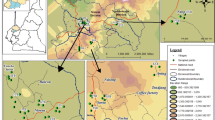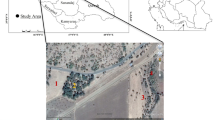Abstract
The study dealt with the assessment of impact of deforestation on soil through a comparative analysis of soil physicochemical properties of natural forest and deforested areas. Soil samples from three depths (top, middle and bottom) under natural forest and nearby deforested areas were collected to investigate soil properties. Forest soils show no significant change in particle size distribution. Bulk density of forested soils shows the significant differences in top and middle layers. Soil pH in top and middle soil, organic matter in top soil and available phosphorus in middle soil of the forest site are found to be significantly higher than that of the deforested soils. Forest soils also have significantly higher level of exchangeable Ca2+, K+ in top and middle soil and Mg2+ at all depth than those of deforested site. Exchangeable Na+ and cation exchange capacity (CEC) are observed unchanged in both sites. The results suggest that change in soil properties was more obvious in surface and sub surface portions of both areas. The study shows that deterioration of physicochemical properties occurred due to deforestation.
Similar content being viewed by others
References
Adams PW, Boyle JR. 1982. Soil fertility changes following clearcut and whole tree harvesting and burning in central Michigan. Soil Science Society of America Journal, 46: 638–640.
Adejuwon JO, Ekanade O. 1987. Edaphic component of the environment degradation resulting from the replacement of tropical rain forest by field and tree crops in SW Nigeria. International Tree Crops Journal, 4: 269–282.
Agboola AA. 1994. A recipe for continuous arable crop production in the forest zone of western Nigeria. In: Sanchez PA, Van Houten H (eds), Alternative to slash-and-burn agriculture. Symposium ID-6. 15th International Soil Science Congress, Mexico, pp.107–120
Allen JC. 1985. Soil response to forest clearing in the United States and the tropics: Geological and biological factors. Biotropica, 17: 15–27.
Amin R, Akonda AW, Neyamat H. 2002. National assessment of forestry restoration policy and practices in South Asia: Bangladesh. IUCN/WWF, 50pp.
Anonymous. 1992. Forestry Master Plan-Main Plan, ADB (TA No.1355-Ban), UNDP/FAO BGD 88/025, 162pp.
Araki S. 1992. The role of miombo woodland ecosystem in chitemene shifting cultivation in northern Zambia. Japan InforMAB, 11: 8–15.
Araujo QR, Comerford NB, Ogram AV, Al-Agely A, Filho LP, Santos JG. 2005. Soil carbon and physical property changes in Brazilian Coastal Tableland soils with land use following deforestation. Agroforestry Systems, 63(2): 193–198.
Black CA. 1965. Methods of Soil Analysis. American Society of Agronomy, Inc. Publisher, Madison, Wisconsin, U.S.A. pp.894–895.
Blake GR. 1965. Bulk density. In: Methods of Soil Analysis. Part 1 (eds. C.A. Black, D.D. Evans, J.L. White. I.E. Ensminger and F.E. Clark). American Society of Agronomy, Inc. Publisher, Madison, Wisconsin, U.S.A.
Biswas SR, Choudhury JK. 2007. Forests and forest management practices in Bangladesh: the question of sustainability. International Forestry Review, 9(2): 627–640 pp.
Boyle JR. 1975. Whole tree harvesting impact on site quality. Paper presenting at the Tappi Annual Meeting, 24–26 February, New York.
Brammer H. 1971. Bangladesh Land Resources Technical Report-3.AGL: SF,Pak-6, FAO, Rome.
Chidumayo EN. 1989. Land use, deforestation and reforestation in the Zambian copperbelt. Land Degradation and Rehabilitation, 1: 209–216.
Chidumayo EN, Kwibisa L. 2003. Effects of deforestation on grass biomass and soil nutrient status in miombo woodland, Zambia. Agriculture, Ecosystems and Environment, 96: 97–105.
Chowdhury MSH, Biswas S, Haque SMS, Muhammed N, Koike M. 2007. Comparative analysis of some selected macronutrients of soil orange orchard and degraded forests in Chittagong Hill Tracts, Bangladesh. Journal of Forest Research, 18(1): 27–30.
Delgado CR, Barcelo G, Parraga J. 1985. Effects of deforestation on the soils of the Antequera region of Malaga, Spain. III. Analysis and evaluation. Ann Edafol Agrobiol, 44: 1015–1027.
FAO. 2001. State of the world’s forests 2001, FAO. Rome.
FAO. 2000. Forest Resources of Bangladesh Country Report, Rome 2000. The Forest Resources Assessment Programme; Originated by: Forestry Department. Available at http://www.fao.org/docrep/007/ad104e/AD104E04.htm#P393_24960
Hajabbasi MA, Jalalian A, Karimzadeh HR. 1997. Deforestation effect on physical and chemical properties, Lordegan, Iran. Plant and Soil, 190: 301–308.
Hendrickson OQ, Chatarpaul L, Burgess D. 1989. Nutrient cycling following whole-tree and conventional harvest in northern mixed forest. Canadian Journal of Forest Research, 19: 725–735.
Hoque AKMF. 1977. Soil erosion in teak plantation. In Proc. of first Bangladesh National Conference on Forestry, Dhaka, Bangladesh, pp. 80–83.
Jackson ML. 1973. Soil Chemical Analysis. Prentice-Hall Inc., Englewood Cliffs, N. Jersey, USA. pp. 205–226.
Johnson CE, Johnson AH, Siccama TG. 1991. Whole-tree clearcutting on exchangeable cations and soil acidity. Soil Science Society of America Journal, 55: 502–508.
Liu SL, Fu BJ, Lu YH, Chen LD. 2002. Effects of reforestation and deforestation on soil properties in humid mountainous areas: a case study in Wolong Nature Reserve, Sichuan province, China. Soil Use and Management, 18: 376–380
Lugo AE, Sanchez MJ. 1986. Land use and organic carbon content of some subtropical soils. Plant and Soil, 96: 185–196.
Lu D, Moran E, Mausel P. 2002. Linking Amazonian secondary succession forest growth to soil properties. Land degradation Division, 13: 331–343.
Minitab Inc. 1996. Minitab user’s guide, release 11. Minitab, State College, PA.
Mongabay. 2000. http://rainforests.mongabay.com/deforestation/2000/Bangladesh.htm
Moyo S, O’Keefe P, Sill M. 1993. The Southern African Environment: Profiles of the SADC Countries. ETC Foundation/Earthscan Publishers, London, 354 pp.
Mroz GD, Jurgensen MF, Frederick D,J. 1985. Soil nutrient changes following whole tree harvesting on tree- northern hardwood sites. Soil Science Society of America, 49: 1552–1557.
Ohta S. 1990. Influence of deforestation on the soils of the Pantabagan area, Central Auzon, Philippines. Soil Science & Plant Nutrition, 36: 561–573.
Patrick JH, Smith DW. 1975. Forest management and nutrient cycling in eastern hardwoods. USDA For. Serv. Res. Pap.ME-4. Northeast For. Exp. Stat. Broomal, PA.
Rasiah V, Kay BD. 1995. Runoff and soil loss as influenced by selected stability parameter and cropping and tillage practices. Geoderma, 68: 321–329.
RSS (Reconnaissance Soil Survey). 1976. Reconnaissance Soil Survey of Sadar South and Cox’s Bazar Subdivision Chittagong District. Department of Soil Survey.Government of the Peoples Republic of Bangladesh, 5pp
Sahani U, Behera N. 2001. Impact of deforestation on soil physicochemical characteristics, microbial biomass and microbial activity of tropical soil. Land Degradation & Development, 12: 93–105.
Saikh H, Varadachari C, Ghosh K. 1998. Effects of deforestation and cultivation on soil CEC and contents of exchangeable bases: A case study in Simlipal National Park, India. Plant and Soil, 204(2): 175–181.
Vagen TG. 2004. Change in soil quality in relation to deforestation and land use change in the highlands of Madagascar. Available at http://www.cababstractsplus.org/google/abstract_learnmore.asp.
Walkley A, Black IA. 1934. An examination of the Degtjareff method for determining soil organic matter and a proposed modification of the chromic acid titration method. Soil Science, 37: 29–38.
Author information
Authors and Affiliations
Corresponding author
Additional information
The online version is available at http://www.springerlink.com
Rights and permissions
About this article
Cite this article
Zaman, M., Osman, K. & Sirajul Haque, S.M. Comparative study of some soil properties in forested and deforested areas in Cox’s Bazar and Rangamati Districts, Bangladesh. Journal of Forestry Research 21, 319–322 (2010). https://doi.org/10.1007/s11676-010-0077-0
Received:
Accepted:
Published:
Issue Date:
DOI: https://doi.org/10.1007/s11676-010-0077-0




